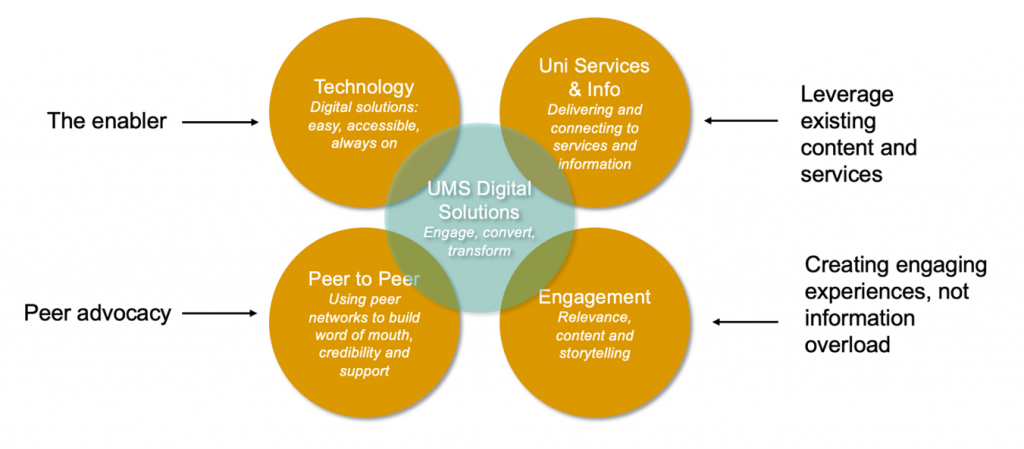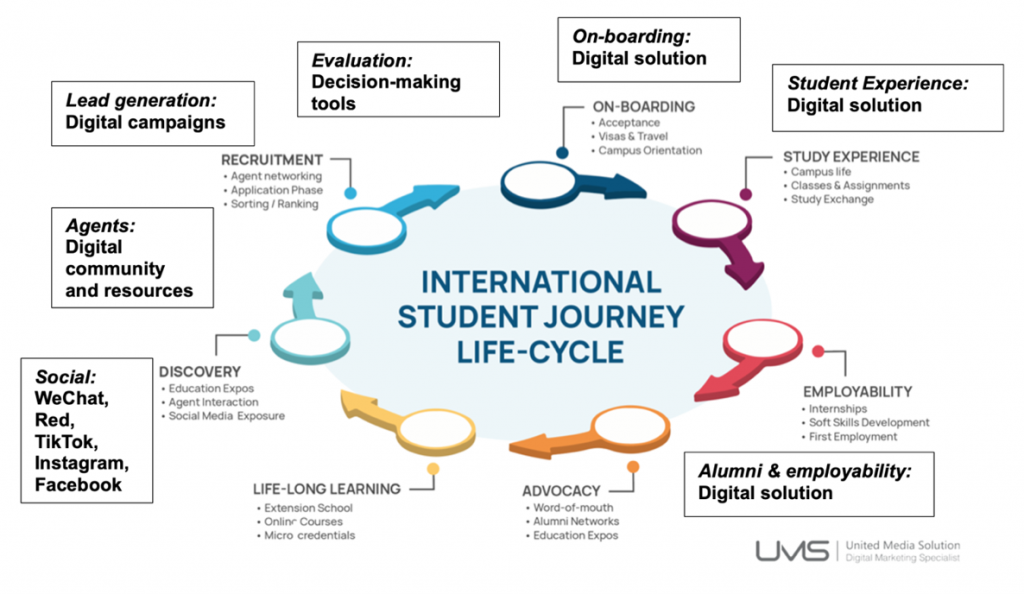Look around any campus in the world today and you’ll notice a sea of faces busy with their smartphones. We’ve all seen how technology has changed our world and has become ever-present in the daily lives of our students.
Students have a wealth of social platforms and digital content to choose from. And this creates a problem for higher education marketers – how do we get their attention and cut through the digital noise?
We’ve observed educators are great at providing information, but this is usually not enough to capture students’ attention. And typically providers’ digital offerings are not connected with their institution’s other services or communities of students.
At UMS we’ve learned the secret to compelling, impactful digital solutions is how you integrate four key elements:
 1. Technology
1. Technology
Technology is not an end in itself. It’s an enabler. It provides us with an always on, accessible and data-rich way of interacting with students. And the continuing innovations in technology across machine learning, other AI, VR, automated marketing and more gives us new opportunities to engage students by providing richer and more personalised experiences.
Whether you’re developing an enterprise wide solution or supporting an event or one-off campaign, your technology solution needs to:
- Be attuned to your students’ digital world and digital behaviours
- Built for mobile-first users
- Capture data and provide analytics
- Integrate with your other technology solutions and services
- Be single-minded about achieving marketing and student experience outcomes.
2. Leverage your services and information
Higher education providers already have a wealth of content and services for prospective and current students and alumni. These can be repurposed to work in a digital environment, be structured by user need and integrated with your other digital platforms and CRM system. As digital solutions, they offer the benefit of being more engaging, interactive and adaptable to an individual student’s need than a printed or PDF prospectus or handbook. And these digital solutions can help prepare and pathway your students to your existing services for enquiries, admissions and international student support.
We recommend developing an “online to offline” strategy for the student journey. This will let you engage and inform your audiences, help direct them to your personal services, and provide a range of learnings and analytics as you do so.
3. Engagement
Digital engagement is created through the combination of three key factors:
- Relevance: Students have different needs at different stages of their journey and as individuals they each will seek information or support differently. The solution is to tailor content to the stage of the journey and UX design that allows for a range of user personas.
- Content: Use short, bite-sized content; avoid long complex narrative; use video, infographics and other visuals.[1] Think of your students’ needs, language, online behaviour and frames of reference. Avoid defaulting to structuring content by your internal categorisations and services. Ensure your UX design lets users quickly navigate between guides on thematic topics (e.g. what it’s like to study in your country, finding a job) and searching for urgent need-to-know information.
- Story-telling: People are more likely to respond to and remember stories than lists of facts or procedures. So use other students’ personal experiences to showcase the benefits of choosing your institution and convey key messages to build a positive student experience. Use storytelling to:
- Differentiate your institution from others and build your brand
- Capture the experience of studying at your institution
- Give important learnings and advice
- Manage expectations around challenges they are likely to face, while showing these challenges can be overcome and will build confidence
- Demonstrate positive outcomes from studying with your institution
- Build agency in the student by sharing the experiences of others.
4. Peer to peer
Students listen to other students.[2] [3] So get the support of fellow students to share key messages. This will give credibility, authenticity and social proof to your messaging. Using social media such as Instagram, Tiktok (or Douyin), Wechat and RED spreads and amplifies word of mouth.
We have found student forums and livestreaming with student voices, integrated into our digital solutions, to be particularly popular and effective. In these sessions students can be supported by experts from your institution or other organisations. However, it is the student voice and lived experience that will help build trust and engagement with your audience.
At UMS we combine marketing leadership with technology expertise to develop digital solutions to engage students across the student journey:
 We’ve achieved outstanding results for our clients with our digital solutions. Our case studies including developing WeChat Chinese agent and student experience mini programs for a government agency, creating integrated marketing campaigns, building a WeChat mini program for student prospect engagement and lead generation, and delivering a virtual student engagement programme for a regional study agency. We also deliver tactical support for universities, such as live-streaming campaigns, development of a mini program for livestreaming a University’s China open day, and event registration mini programs.
We’ve achieved outstanding results for our clients with our digital solutions. Our case studies including developing WeChat Chinese agent and student experience mini programs for a government agency, creating integrated marketing campaigns, building a WeChat mini program for student prospect engagement and lead generation, and delivering a virtual student engagement programme for a regional study agency. We also deliver tactical support for universities, such as live-streaming campaigns, development of a mini program for livestreaming a University’s China open day, and event registration mini programs.
We are finalists for our client digital work in the Marketing Campaign of the Year and Student Support categories of the 2024 PIEoneer Awards.
Talk to Becty now to see how we can help you create a great student experience for your students.
—
[1] For a summary of Gen Z’s students’ content preferences, see Chan, C.K.Y., Lee, K.K.W. “The AI generation gap: Are Gen Z students more interested in adopting generative AI such as ChatGPT in teaching and learning than their Gen X and millennial generation teachers?”. Smart Learn. Environ. 10, 60, pp 5-6 (2023). https://doi.org/10.1186/s40561-023-00269-3
[2] For example, in Education New Zealand’s International Student Experience Survey 2023, p38, international students ranked friends in country as the highest option for support, ahead of parents and lecturers, teachers and tutors. Retrieved from https://intellilab.enz.govt.nz/document/721-international-student-experience-survey-2023-report
[3] See also Global insights: what are the experiences of Chinese students in the UK? UCAS, Pearson, December 2023, p26. https://www.ucas.com/rising-popularity-creative-arts-among-chinese-students-can-help-maintain-uks-competitive-global?hash=tY9w72hGTjdIsY9jcBNTeGMVc5SjfUoMN41sfU5vur0













